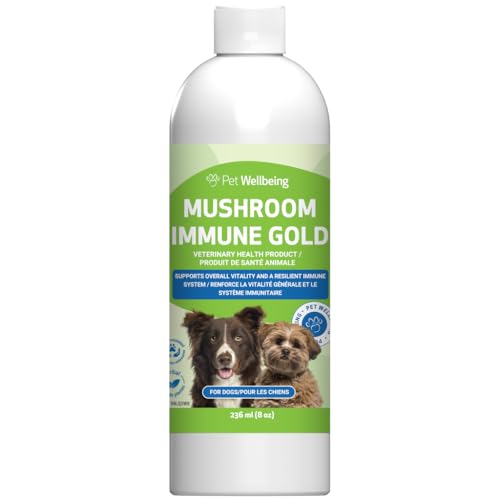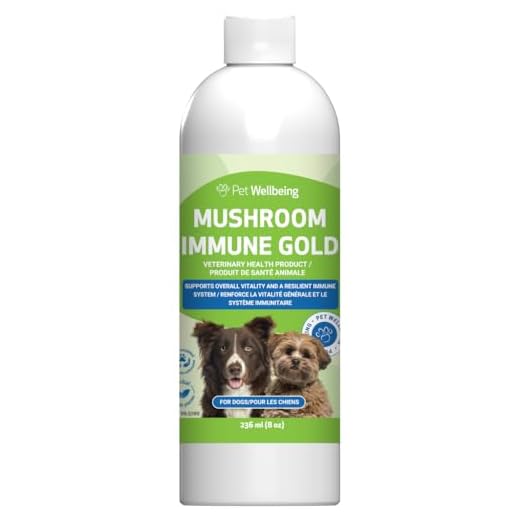


Always keep an eye on what your furry friend is munching! While many varieties of fungi are harmless, some can pose serious health risks. It’s crucial to identify which types are safe and which can be dangerous. If you spot your pet sniffing around or attempting to eat any wild specimens, intervene immediately to prevent potential harm.
In my experience, I once noticed my Labrador, Max, curiously investigating some mushrooms in the park. I quickly recalled a friend’s story about their dog suffering from severe gastrointestinal upset after ingesting a certain species. This prompted me to educate myself more on the matter. I learned that certain wild varieties can lead to symptoms like vomiting, diarrhoea, and lethargy, and in extreme cases, even liver failure. Always consult a veterinarian if you suspect your pet has ingested something harmful.
When it comes to commercial options, many cultivated types are safe, but it’s best to introduce them gradually into your pet’s diet. Cooking them can also help eliminate any potential toxins that might be present. Always err on the side of caution, and consult your vet when in doubt. Your canine companion’s safety should always come first!
Are Mushrooms Hazardous to Canines?
It’s crucial to avoid any fungi when it comes to pets. Some varieties can lead to severe health issues or even be lethal. If your furry friend ingests a wild type, immediate veterinary attention is necessary, even if symptoms aren’t apparent right away.
Knowing the signs of consumption is beneficial. Symptoms can range from vomiting and diarrhea to more severe reactions like seizures or lethargy. Always monitor your pet closely after a walk in wooded areas or parks known for their plant life.
In my experience, I once noticed my dog sniffing around a cluster of wild fungi during our walk. Thankfully, I intervened before he could sample them. I recommend carrying a list of common harmful types or using an app to identify flora in your surroundings. Prevention is key; keep your canine on a leash and discourage any foraging.
Educating yourself on local species is invaluable. Some can appear harmless but possess dangerous compounds. Always err on the side of caution and consult a vet if unsure. Your pet’s safety is paramount, and being informed can save their life.
Identifying Common Toxic Mushrooms
Recognising hazardous fungi is crucial. One of the most notorious culprits is the Amanita phalloides, commonly known as the death cap. This variety is often mistaken for edible types, featuring a greenish-yellow cap and white gills. Consuming even a small amount can be fatal.
Another risky species is the Amanita muscaria, or fly agaric. With its striking red cap adorned with white spots, it may look appealing, but ingestion can lead to severe neurological symptoms. Keep an eye out for this one, especially in wooded areas.
Gyromitra spp., known as false morels, are also dangerous. Their lobed shape can resemble true morels, but they contain toxins that can cause serious gastrointestinal distress. Look for irregular, lobed caps that vary in colour from brown to reddish.
In addition, the Cortinarius spp. contains deadly compounds. These fungi tend to have a distinctive web-like veil covering their caps. Symptoms may not appear immediately, making them particularly deceptive.
Lastly, beware of the Clitocybe spp., often referred to as the “fool’s funnel.” These fungi can be white or light-coloured and are known for causing severe poisoning. Their funnel shape is a telltale sign.
Always exercise caution when encountering wild fungi. If you suspect that your pet has ingested any harmful variety, seek veterinary assistance immediately. Identifying these species can save lives.
Symptoms of Mushroom Poisoning in Dogs
If you suspect that your pet has ingested a harmful fungus, be alert for specific signs that could indicate poisoning. The initial symptoms may manifest within hours of consumption, so prompt attention is critical.
Gastrointestinal Distress
One of the first indications of trouble includes vomiting, which may be accompanied by diarrhoea. Watch for any signs of nausea, such as drooling or attempts to vomit without success. Abdominal pain may also be evident, with your furry friend exhibiting discomfort or reluctance to move.
Neurological Effects
More severe reactions can affect the nervous system. Symptoms such as tremors, seizures, or uncoordinated movements should not be ignored. Confusion or unusual behaviour, like excessive barking or disorientation, can also occur. If you notice any of these signs, seek veterinary assistance immediately.
Keep a close eye on your companion after any outdoor exploration, especially in areas where wild fungi grow. Timely intervention can make a significant difference in recovery.
Immediate Actions to Take if Your Dog Eats Mushrooms
If your furry friend ingests a wild fungus, act quickly. First, assess the situation: observe your pet for any immediate signs of distress. If you notice vomiting, lethargy, or unusual behaviour, call your vet right away.
What to Do Next
Gather as much information as possible. Take a photo of the mushroom or collect a sample if safe to do so. This will help the veterinarian identify the species and determine the best course of action. Do not induce vomiting unless specifically instructed by a veterinary professional.
Information to Provide the Vet
When you contact your vet, share details about your pet’s size, age, and any symptoms observed. It’s also vital to inform them of the time of ingestion and the type of fungus, if known. This information can significantly influence the treatment approach.
| Action | Description |
|---|---|
| Stay Calm | Keep your composure to effectively assess the situation. |
| Check Symptoms | Look for signs such as vomiting, drooling, or seizures. |
| Contact a Vet | Call your veterinary clinic immediately. |
| Document Details | Take pictures or collect samples of the fungus. |
| Follow Vet Instructions | Adhere strictly to any advice or treatment recommendations. |
Time is of the essence in such cases. Quick action can make a significant difference in your pet’s health.
Preventing Mushroom Ingestion During Walks
Keep your canine companion on a short lead while strolling through areas where fungi thrive. This simple action reduces the chance of your pet wandering off to nibble on hazardous growths. Regular training can reinforce the “leave it” command, ensuring your furry friend avoids potential dangers during outings.
Strategies for Safe Walks
- Stick to Designated Paths: Always choose well-trodden trails. Avoid letting your pet roam in overgrown areas where wild varieties may flourish.
- Visual Checks: Before letting your pup explore, scan the ground for any suspicious growths. If you notice any, redirect your dog’s attention immediately.
- Distraction Techniques: Carry toys or treats to keep your dog’s focus away from the ground. Engaging them in play can help steer them clear of unwanted snacking.
- Education: Familiarise yourself with the local flora. Knowing which types are harmful enables you to take proactive measures.
What to Do If You Spot Fungi
If you come across any fungi during your walk, calmly lead your pet away and reward them for following your commands. If you’re unsure about a particular type, consult resources or professionals after your walk. Always remember to educate fellow dog owners in your area about potential hazards.
Lastly, while you’re preparing meals at home, consider trying recipes like how to cook chicken kabobs on cast iron skillet to keep your furry friend happy with healthy treats instead of risky foraging.
Consulting a Vet: When and Why It’s Necessary
Seek veterinary advice immediately if you suspect your furry friend has consumed any wild fungi. It’s better to err on the side of caution, especially since some varieties can cause severe reactions. A vet can provide appropriate tests and treatments tailored to your pet’s condition.
Recognising Symptoms
Watch for signs such as vomiting, diarrhoea, excessive drooling, or lethargy. If you notice any of these symptoms, contact your veterinarian right away. Quick action can make a significant difference in your companion’s recovery.
Follow-Up Care
Even if your pet seems fine, a follow-up appointment is wise. Some effects may not show up immediately. Your vet might recommend monitoring your pet’s health over the next few days, ensuring no delayed reactions occur. Nutrition plays a vital role in recovery, so consider looking into the best dog food for oily coat if your pup needs dietary adjustments.







